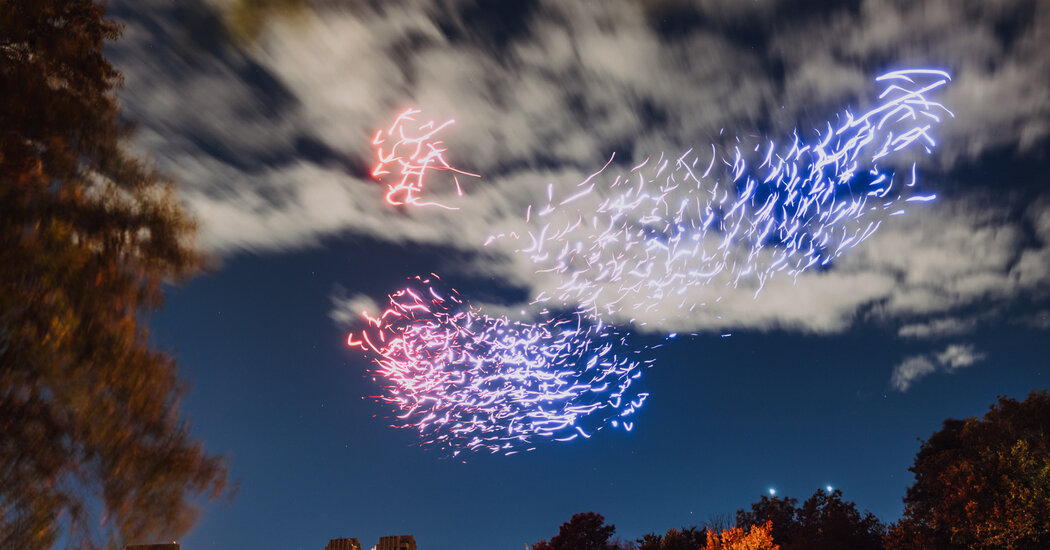It began with a sudden, breathtaking emergence over the trees to the south — a thousand points of blue light that expanded and dispersed into the sky. They organized into a kind of butterfly formation and set off in a northerly direction — and then the flotilla vanished, as if at the flip of a switch. Several beats later, it reappeared, to loud oohs and aahs from the crowd, as a stunning grid of white, pink and ruby luminosity.
It took five years to cut through New York City red tape before the Dutch collective Drift could release its synchronized flock of 1,008 small, light-emitting drones above Central Park. But on Saturday night, there they were, making their debut over The Lake, in designated airspace, for nearly seven minutes: a murmuration rising, swooping, blinking and changing color to the delight of thousands of spectators who gathered for performances at 7, 8, and 9 p.m.
Most viewers were concentrated around Bethesda Fountain on the 72nd Street Transverse, and three other recommended viewing areas; others watched the performance, titled “Franchise Freedom,” in reclining positions, through a canopy of still leafy trees, and claimed it was just as beautiful.
Prominent among the delighted was Drift, a collective formed by the Dutch artists Lonneke Gordijn and Ralph Nauta in 2007. They seem to make a good team; Grodijn has long been a close observer of nature, especially bird swarms known as murmurations, and Nauta has allied himself with science-fiction-nourished “tech nerds.”
Soon, the pair, who graduated from the Design Academy Eindhoven — where they met in 1999 — found themselves collaborating with a growing number of programmers, engineers and choreographers and dreaming of an outdoor performance in New York. Previous sites for performances since 2017 include Miami (adjacent to Art Basel Miami Beach), the Burning Man Festival, the Kennedy Space Center and Rotterdam, in the Netherlands. In New York Drift staged a large exhibition of installations and performances at the Shed in 2021, and “Shylight,” a kinetic, site-specific installation of silk-draped lights that floated like small parachutes, rising and descending in the lobby of the David H. Koch Theater at Lincoln Center earlier this year.
Their Central Park proposal seems to have captured the imagination of Mayor Eric Adams, who provided crucial support, but not everyone was pleased. The New York chapter of the Audubon Society objected that migrating birds would be endangered — “This is a VERY BAD IDEA,” the group posted on X, the website formerly known as Twitter. “COULD WE MOVE THIS to after fall migration?” (The city’s Department of Parks & Recreation said the group was in compliance with its rules regarding drones over Central Park.) For a while, things were a little touch and go. The event was not announced until a few weeks ago, although by Saturday, it was apparent that word had gotten out.
As a title, “Franchise Freedom” has a slightly unappetizing sound; it inadvertently recalls the U.S. government’s onetime ambition to promote democracy around the world. The rendering of the work accompanying the press material made it look like the flocks of lights were attacking some of New York’s newer, taller buildings just south of the park.
But from my vantage point at least, “Franchise Freedom” was serenely beautiful, like an enormous lava lamp, made with points of lights instead of oozing goop. Comparisons to slow motion or silent fireworks were also overheard. Once the blue lights gave way to the rosier ones, the action began.
When the loosely rectangular grid passed over the Lake, almost immediately the rectangle broke into clusters, large and small, swelling and curling, dividing somewhat according to color into amorphous shapes in constant motion.
Sometimes tiny bunches of lights — or even two or three — would break off like a little scouting party and then rejoin a larger group. Perhaps most interesting was the way the different configurations flattened out, suggesting bejeweled nets. After several minutes the lights switched off again, to reappear as blue and funnel back over the horizon.
Viewers were invited to log into studiodrift.com and download a fittingly Satie-like soundtrack by the composer Joep Beving. If you didn’t, the drones collectively emitted a soft whir that was quite wonderful — a sonic, somewhat electronic murmuration.
The New York presentation of “Franchise Freedom” was sponsored primarily by Therme US, the North American component of a global corporation with plans to build aquatic wellness centers in various cities, including 10 in the United States — designed and priced to accommodate large numbers of people.
While “Franchise Freedom” has been touted as the largest public art work in Central Park since Christo and Jeanne-Claude’s “The Gates” in 2005, it is minuscule in comparison. “The Gates,” which took 26 years to bring to fruition, lasted 16 days and accented miles of park pathways with 7,500 raised orange banners that formed a billowy show of saffron ribbon.
“Franchise Freedom” provided a lovely experience, but it was brief and simplistic as a work of performative art — and that might have been due to the cramped amount of air space and time allotted. Looking at videos from Drift’s Burning Man performance indicates a more expansive, almost symphonic complexity. Here their project is overshadowed even by the annual New Year’s Eve fireworks display over the park.
Its depth lies primarily in the technological effort and skill required to create the murmuration effect — no mean feat. But it’s not clear if Central Park is their best platform or if it allowed them to live up to their ambition to “reconnect humanity with nature through technology.” It felt more like a sample, a prelude, which makes me anticipate what Drift will come up with next. It seems certain that neither the artists nor their chosen tools will stand still.
